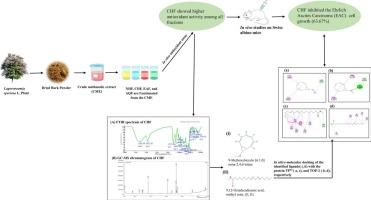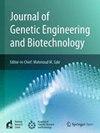Exploring the anticancer and antioxidant properties of Lagerstroemia speciosa bark extract via phytochemical and molecular docking analysis
IF 2.8
Q3 Biochemistry, Genetics and Molecular Biology
Journal of Genetic Engineering and Biotechnology
Pub Date : 2025-08-14
DOI:10.1016/j.jgeb.2025.100553
引用次数: 0
Abstract
Lagerstroemia speciosa is traditionally used for treating diabetes and inflammation; however, its anticancer potential remains unexplored. This study assesses the antioxidant and anticancer activities of L. speciosa bark extract, with a focus on Ehrlich Ascites Carcinoma (EAC) cells in mice. The crude methanol extract (CME) was subdivided into n-hexane (NHF), chloroform (CHF), ethyl acetate (EAF), and aqueous (AQF) fractions. In vitro antioxidant assays identified CHF as the most active fraction, exhibiting high phenolic and flavonoid content. CHF and EAF were further investigated for anticancer activity in an EAC-induced mouse model, where CHF significantly (P < 0.05) reduced tumor cell count compared to EAF. Phytochemical characterization using FTIR and GC–MS revealed bioactive compounds, including 9-Methoxybicyclo[6.1.0]nona-2,4,6-triene and 9,12-Octadecadienoic acid methyl ester (E,E). Molecular docking studies demonstrated strong interactions between these compounds and key cancer-related proteins, p53 and Topoisomerase-II, suggesting potential anticancer mechanisms. Overall, this study shows that L. speciosa bark extract has therapeutic potential, especially for CHF. Bioactive compounds like 9,12-octadecadienoic acid methyl ester (E,E) and 9-methoxybicyclo [6.1.0]nona-2,4,6-triene contribute to the extract’s antioxidant and anticancer effects in EAC models, possibly by modulating p53 and Topoisomerase-II.

通过植物化学和分子对接分析,探讨紫薇树皮提取物的抗癌和抗氧化作用
紫薇花传统上用于治疗糖尿病和炎症;然而,它的抗癌潜力仍未被发掘。本研究以小鼠埃利希腹水癌(EAC)细胞为研究对象,研究了白桦树皮提取物的抗氧化和抗癌活性。粗甲醇提取物(CME)被细分为正己烷(NHF)、氯仿(CHF)、乙酸乙酯(EAF)和水(AQF)馏分。体外抗氧化实验表明,CHF是最具活性的部位,具有较高的酚类和类黄酮含量。在eac诱导的小鼠模型中进一步研究了CHF和EAF的抗癌活性,其中CHF显著(P <;0.05)与EAF相比,肿瘤细胞计数减少。利用红外光谱(FTIR)和气相色谱-质谱(GC-MS)进行植物化学表征,发现化合物中含有9-甲氧基双环[6.1.0]诺-2,4,6-三烯和9,12-十八烯二烯酸甲酯(E,E)。分子对接研究表明,这些化合物与关键的癌症相关蛋白p53和拓扑异构酶- ii之间存在强相互作用,提示潜在的抗癌机制。综上所述,本研究表明白桦树皮提取物具有一定的治疗潜力,尤其是对慢性心力衰竭的治疗。在EAC模型中,9,12-十八烯二烯酸甲酯(E,E)和9-甲氧基双环[6.1.0]nona-2,4,6-三烯等生物活性化合物可能通过调节p53和拓扑异构酶- ii参与了提取物的抗氧化和抗癌作用。
本文章由计算机程序翻译,如有差异,请以英文原文为准。
求助全文
约1分钟内获得全文
求助全文
来源期刊

Journal of Genetic Engineering and Biotechnology
Biochemistry, Genetics and Molecular Biology-Biotechnology
CiteScore
5.70
自引率
5.70%
发文量
159
审稿时长
16 weeks
期刊介绍:
Journal of genetic engineering and biotechnology is devoted to rapid publication of full-length research papers that leads to significant contribution in advancing knowledge in genetic engineering and biotechnology and provide novel perspectives in this research area. JGEB includes all major themes related to genetic engineering and recombinant DNA. The area of interest of JGEB includes but not restricted to: •Plant genetics •Animal genetics •Bacterial enzymes •Agricultural Biotechnology, •Biochemistry, •Biophysics, •Bioinformatics, •Environmental Biotechnology, •Industrial Biotechnology, •Microbial biotechnology, •Medical Biotechnology, •Bioenergy, Biosafety, •Biosecurity, •Bioethics, •GMOS, •Genomic, •Proteomic JGEB accepts
 求助内容:
求助内容: 应助结果提醒方式:
应助结果提醒方式:


